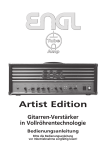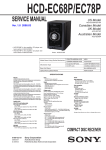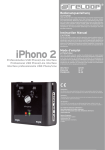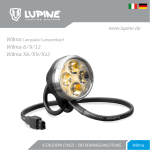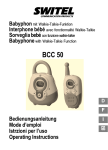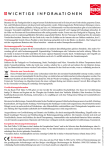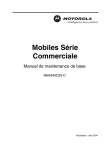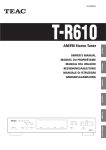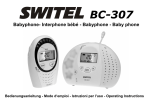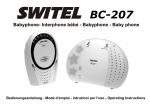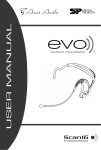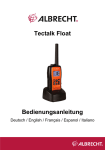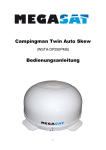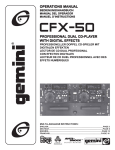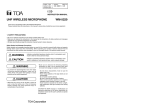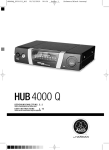Download Datasheet - VideoCentric
Transcript
OPERATIONS MANUAL BEDIENUNGSHANDBUCH MANUAL DEL OPERADOR MANUEL D’INSTRUCTIONS UX-I6 M, H, & L PRO WIRELESS UHF MICROPHONE SYSTEM PROFESSIONAL UHF MICROPHONE SYSTEMS PROFESSIONELLE UHF MIKROPHON SYSTEME SISTEMAS DE FRECUENCIA UHF PROFESIONALES DEL MICRÓFONO SYSTÈMES À FRÉQUENCE UHF PROFESSIONNELS DE MICROPHONE MULTI LANGUAGE INSTRUCTIONS: English...............................................................................................................Page 2 Deutsch.............................................................................................................Page 6 Español..............................................................................................................Page 8 Francais..........................................................................................................Page 10 (1) PLEASE READ BEFORE USING APPLIANCE, IMPORTANT WARNING & SAFETY INSTRUCTIONS! CAUTION RISK OF ELECTRICAL SHOCK DO NOT OPEN! CAUTION: THIS PRODUCT SATISFIES FCC REGULATIONS WHEN SHIELDED CABLES AND CONNECTORS ARE USED TO CONNECT THE UNIT TO OTHER EQUIPMENT. TO PREVENT ELECTROMAGNETIC INTERFERENCE WITH ELECTRIC APPLIANCES SUCH AS RADIOS AND TELEVISIONS, USE SHIELDED CABLES AND CONNECTORS FOR CONNECTIONS. THE EXCLAMATION POINT WITHIN AN EQUILATERAL TRIANGLE IS INTENDED TO ALERT THE USER TO THE PRESENCE OF IMPORTANT OPERATING AND MAINTENANCE (SERVICING) INSTRUCTIONS IN THE LITERATURE ACCOMPANYING THE APPLIANCE. THE LIGHTNING FLASH WITH ARROWHEAD SYMBOL, WITHIN AN EQUILATERAL TRIANGLE, IS INTENDED TO ALERT THE USER TO THE PRESENCE OF UNINSULATED “DANGEROUS VOLTAGE” WITHIN THE PRODUCT’S ENCLOSURE THAT MAY BE OF SUFFICIENT MAGNITUDE TO CONSTITUTE A RISK OF ELECTRIC SHOCK TO PERSONS. READ INSTRUCTIONS: All the safety and operating instructions should be read before the product is operated. RETAIN INSTRUCTIONS: The safety and operating instructions should be retained for future reference. HEED WARNINGS: All warnings on the product and in the operating instructions should be adhered to. POWER-CORD PROTECTION: Power-supply cords should be routed so that they are not likely to be walked on or pinched by items placed upon or against them, paying particular attention to cords at plugs, convenience receptacles, and the point where they exit from the product. OUTDOOR ANTENNA GROUNDING: If an outside antenna or cable system is connected to the product, be sure the antenna or cable system is grounded so as to provide some protection against voltage surges and built-up static charges. Article 810 of the National Electrical Code, ANSI/NFPA 70, provides information with regard to proper grounding of the mast and supporting structure, grounding of the lead-in wire to an antenna discharge unit, size of grounding conductors, location of antenna-discharge unit, connection to grounding electrodes, and requirements for the grounding electrode. See Figure B. LIGHTNING: For added protection for this product during a lightning storm, or when it is left unattended and unused for long periods of time, unplug it from the wall outlet and disconnect the antenna or cable system. This will prevent damage to the product due to lightning and power-line surges. POWER LINES: An outside antenna system should not be located in the vicinity of overhead power lines or other electric light or power circuits, or where it can fall into such power lines or circuits. When installing an outside antenna system, extreme care should be taken to keep from touching such power lines or circuits as contact with them might be fatal. FOLLOW INSTRUCTIONS: All operating and use instructions should be followed. CLEANING: The product should be cleaned only with a polishing cloth or a soft dry cloth. Never clean with furniture wax, benzine, insecticides or other volatile liquids since they may corrode the cabinet. OVERLOADING: Do not overload wall outlets, extension cords, or integral convenience receptacles as this can result in a risk of fire or electric shock. ATTACHMENTS: Do not use attachments not recommended by the product manufacturer as they may cause hazards. OBJECT AND LIQUID ENTRY: Never push objects of any kind into this product through openings as they may touch dangerous voltage points or short-out parts that could result in a fire or electric shock. Never spill liquid of any kind on the product. WATER AND MOISTURE: Do not use this product near water, for example, near a bathtub, wash bowl, kitchen sink, or laundry tub; in a wet basement; or near a swimming pool; and the like. ACCESSORIES: Do not place this product on an unstable cart, stand, tripod, bracket, or table. The product may fall, causing serious injury to a child or adult, and serious damage to the product. Use only with a cart, stand, tripod, bracket, or table recommended by the manufacturer, or sold with the product. Any mounting of the product should follow the manufacturer’s instructions, and should use a mounting accessory recommended by the manufacturer. CART: A product and cart combination should be moved with care. Quick stops, excessive force, and uneven surfaces may cause the product and cart combination to overturn. See Figure A. VENTILATION: Slots and openings in the cabinet are provided for ventilation and to ensure reliable operation of the product and to protect it from overheating, and these openings must not be blocked or covered. The openings should never be blocked by placing the product on a bed, sofa, rug, or other similar surface. This product should not be placed in a built-in installation such as a bookcase or rack unless proper ventilation is provided or the manufacturer’s instructions have been adhered to. SERVICING: Do not attempt to service this product yourself as opening or removing covers may expose you to dangerous voltage or other hazards. Refer all servicing to qualified service personnel. DAMAGE REQUIRING SERVICE: Unplug this product from the wall outlet and refer servicing to qualified service personnel under the following conditions: • When the power-supply cord or plug is damaged. • If liquid has been spilled, or objects have fallen into the product. • If the product has been exposed to rain or water. • If the product does not operate normally by following the operating instructions. Adjust only those controls that are covered by the operating instructions as an improper adjustment of other controls may result in damage and will often require extensive work by a qualified technician to restore the product to its normal operation. • If the product has been dropped or damaged in any way. • When the product exhibits a distinct change in performance, this indicates a need for service. REPLACEMENT PARTS: When replacement parts are required, be sure the service technician has used replacement parts specified by the manufacturer or have the same characteristics as the original part. Unauthorized substitutions may result in fire, electric shock, or other hazards. POWER SOURCES: This product should be operated only from the type of power source indicated on the marking label. If you are not sure of the type of power supply to your home, consult your product dealer or local power company. SAFETY CHECK: Upon completion of any service or repairs to this product, ask the service technician to perform safety checks to determine that the product is in proper operating condition. LOCATION: The appliance should be installed in a stable location. WALL OR CEILING MOUNTING: The product should not be mounted to a wall or ceiling. NON-USE PERIODS: The power cord of the appliance should be unplugged from the outlet when left unused for a long period of time. HEAT: The product should be situated away from heat sources such as radiators, heat registers, stoves, or other products (including amplifiers) that produce heat. GROUNDING OR POLARIZATION: • If this product is equipped with a polarized alternating current line plug (a plug having one blade wider than the other), it will fit into the outlet only one way. This is a safety feature. If you are unable to insert the plug fully into the outlet, try reversing the plug. If the plug should still fail to fit, contact your electrician to replace your obsolete outlet. Do not defeat the safety purpose of the polarized plug. • If this product is equipped with a three-wire grounding type plug, a plug having a third (grounding) pin, it will only fit into a grounding type power outlet. This is a safety feature. If you are unable to insert the plug into the outlet, contact your electrician to replace your obsolete outlet. Do not defeat the safety purpose of the grounding type plug. (2) U X-16 UX-16 RECIEVER XM-16 HANDHELD MICROPHONE XB-16 BODYPACK TRANSMITTER (3) INTRODUCTION: (4) ANTENNA: Fixed-length UHF antenna permanently mounted either on the front or on rear panel. Congratulations on your purchase of a GEMINI wireless system. This state of the art unit includes all the latest features backed by a three year limited warranty. Prior to use, we suggest that you carefully read the instructions. (5) UNBALANCED OUTPUT: Unbalanced 1/4” mono jack audio output provides unbalanced low-impedance output (6) SQUELCH ADJ.: The squelch adjusts the output level to prevent from the external noise. Setting the squelch too high will reduce the range of the system. Set the squelch to minimum before turning the receiver on. SYSTEM FEATURES: • • • • • • • • • • UX-16 M includes UX-16 receiver & XM-16 handheld microphone UX-16 H includes UX-16 receiver, XB-16 body pack transmitter & HSM-1 headset UX-16 L includes UX-16 Receiver, XB-16 body pack transmitter & LAV-1 lavalier 16 band UHF synthesizer controlled frequencies Phase locked loop (PLL) circuitry Super high sensitivity with extremely low noise transmission & reception Stable & quality SMT assembled PCB module XM-16 has a uni-directional dynamic microphone HSM-1 has an electret condenser unit microphone LAV-1 has an electret condenser unit microphone (7) CHANNEL SELECTOR: 16 different selectable frequencies as below. CAUTIONS: 1. All operating instructions should be read before using this equipment. 2. To reduce the risk of electrical shock, do not open the unit. THERE ARE NO USER REPLACEABLE PARTS INSIDE. Please refer servicing to a qualified service technician. (8) DC JACK: DC input connector for the supplied AC adapter. 3. Do not expose this unit to direct sunlight or to a heat source such as a radiator or stove. XM-16 HANDHELD MICROPHONE: 4. Dust, dirt and debris can interfere with the performance of this unit. Make an effort to keep the unit away from dusty, dirty environments, and cover the unit when it is not in use. Dust it regularly with a soft, clean brush. The handheld microphone operates in UHF band frequency with PLL synthesized control. UHF 16 preprogrammed selectable frequencies to avoid interference. Uni-directional dynamic or uni-directional electret condenser capsules with different characters for various choices. Use 1.5V x 2 AA size batteries for low operating cost. 5. When moving this equipment, it should be placed in its original carton and packaging. This will reduce the risk of damage during transit. (1) GRILLE: Protects the microphone capsule and helps reduce breath sounds and wind noise. The grille for the various microphone capsules differ in appearance. 6. DO NOT EXPOSE THIS UNIT TO RAIN OR MOISTURE. 7. DO NOT USE ANY SPRAY CLEANER OR LUBRICANT ON ANY CONTROLS OR SWITCHES. (2) LOW BATTERY LED: LED indicates battery status. Switching the power to “ON”, the LED flashing once indicates that the transmitter has sufficient power. If the LED stays on, it indicates that the battery has insufficient power and should be changed soon. If the status LED fails to flash, the battery is either dead or not positioned correctly, and you should correct the positioning or change the battery. 8. REMEMBER, ANY CHANGES MADE TO THE UNIT WITHOUT AUTHORIZATION FROM GEMINI WILL VOID YOUR WARRANTY. FCC RULES AND REGULATIONS: This device complies with part 15 of the FCC rules. Operation is subject to the following two conditions: (1)This device may not cause harmful interference and (2) This device must accept any interference received, including interference that may cause undesired operation Notice: The changes or modifications not expressly approved by the party responsible for compliance could void the user’s authority to operate the equipment. (3) ON/OFF SWITCH: Turns transmitter power on and off. (4) BATTERY COMPARTMENT: Insert two AA batteries into the compartment and make sure that the polarity of batteries is correct. (5) CHANNEL SELECTOR: Changes transmitter channel setting. (6) BATTERY COVER: Push to expose battery compartment and channel selector. Important note, to comply with the FCC RF exposure compliance requirements, no change to the antenna or the device is permitted. Any change to the antenna or the device could result in the device exceeding the RF exposure requirements and void user’s authority to operate the device. (7) ANTENNA: Built-in high gain helical antenna. XB-16 BODYPACK TRANSMITTER: The bodypack transmitter operates in UHF band frequency with PLL synthesized control. UHF 16 preprogrammed selectable frequencies to avoid interference. Various uni-directional electret condenser capsule options. Use 1.5V x 2 AA size batteries for low operating cost. UX-16 WIRELESS SYSTEM: The UX-16 wireless system is a high quality audio product that provides excellent performance under most operating conditions. The different systems available all operate on a UHF high band frequency between USA: 790-806 MHz / Europe: 863-865 MHz. WIRELESS NOTES: • Before setting up, make sure that the transmitter and receiver are tuned to the same frequency. • Do not use two transmitters in the same frequency. Use good quality batteries to avoid the damage resulting from a defective leaking battery. • Turn the volume control on the receiver to adjust receiver output level to match input level requirements of an audio mixer or amplifier. (1) CONNECTOR: 1/8” miniplug microphone connector (2) ON/OFF SWITCH: Turns transmitter power on and off. (3) LOW BATTERY LED: LED indicates battery status. Switching the power to “ON”, the LED flashing once indicates that the transmitter has sufficient power. If the LED stays on, it indicates that the battery has insufficient power and should be changed soon. If the status LED fails to flash, the battery is either dead or not positioned correctly, and you should correct the positioning or change the battery. • While checking sound, move the transmitter around the area where you use the system to look for dead spots. If you find any dead spot, change the receiver position. If it does not work, avoid such places. (4) ANTENNA: Permanently connected, helical antenna. • To avoid interference, do not put the receiver too near metal object and avoid obstructions between transmitter and receiver. (6) GAIN: The rotary control adjusts the sensitivity of the transmitter’s audio to the level of the connected lapel microphone or instrument. • Avoid the interference from TV, radio, other wireless appliances and etc. (7) BATTERY COMPARTMENT: Insert two AA batteries into the compartment and make sure that the polarity of batteries is correct. (5) CHANNEL SELECTOR: Changes transmitter channel setting. FUNCTION DESCRIPTIONS: SETTING UP: UX-16 RECEIVER: Prior to setting up, check that the transmitter and receiver are tuned to the same frequency. Two or above transmitters operating in the same frequency can not be used at the same time and area, so please select the different frequencies which can be used simultaneously at local area. This is a stationary receiver for use with our 16-channel selectable transmitters. The receiver operates in UHF band frequency with PLL synthesized control. Powered by 12V DC. (1) POWER INDICATOR: The indicator LED lights when the receiver is ready to operate. (2)RF LEVEL INDICATORS: This LED lights to indicate that signal is being received. (3) LEVEL CONTROL: This rotary control adjusts the receiver’s output level from the microphone to line level for matching the input sensitivity of the mixer or amplifier. (4) BASIC CONNECTIONS: CONNECTING AN INSTRUMENT Connect the receiver output to the audio mixer or amplifier input, using a standard audio cable with the 1/4” phone plugs. • Open the battery cover. Push the MIC/LINE switch to “LINE” and use the supplied screwdriver to adjust the GAIN at appropriate position. • Plug the 1/4” phone plug of the optional guitar cable to the output jack on the instrument and the 1/8” mini plug into audio input connector on the bodypack transmitter. • Switch the transmitter and hi-fi appliance (amplifier, tape deck etc.) power on. • Play the instrument for testing and adjust the levels on your mixer or amplifier. TROUBLE-SHOOTING: NO SOUND: Check the power supply of the microphone and receiver. Check that the transmitter and receiver are tuned to the same frequency. Check whether the hi-fi appliance is switched on and the receiver output is connected to mixer or amplifier input. Check whether transmitter is too far away from receiver or SQUELCH control set too high. Check whether receiver is located too near metal object or there are obstructions between transmitter and receiver. CONNECTING THE RECEIVER TO POWER: SOUND INTERFERENCE: • Point the antennas upward. • Check that the voltage of the supplied AC adapter (AC110 or AC220) conforms to the voltage available in local area. Using the wrong AC adapter may cause irreparable damage to the unit. Check the antenna location. When using 2 or above microphone sets simultaneously, make sure that the chosen frequencies are not interfered. Check whether the interference comes from other wireless microphones, TV, radio and etc. • Plug the feeder cable of the supplied AC adapter into DC IN socket on the receiver. Then plug the AC adapter into a power outlet. DISTORTION: CONNECTING THE RECEIVER TO AN AUDIO MIXER OR AN AMPLIFIER: Check the volume level of the receiver is set too high or too low. Check whether the interference comes from other wireless microphones, TV, radio and etc. In order to make sure the sound quality and avoid distortion, please adjust the volume level according to following instructions. SPECIFICATIONS: INSERTING BATTERIES INTO THE HANDHELD/ BODYPACK TRANSMITTER: • Push to open the battery cover and insert batteries into the battery compartment conforming to the polarity (+)(-) marks. The transmitter can not work with incorrectly inserted batteries. • When push the ON/OFF switch to “ON” to switch the power on, the LED will flash momentarily. If the battery has sufficient power, the LED flashes once. If the LED stayed on, it indicates that the battery has insufficient power and should be changed soon. If the status LED fails to flash, the battery is either dead or not positioned correctly, and you should correct the positioning or change the battery. • Push back the battery cover to click it shut. SETTING UP THE HANDHELD TRANSMITTER: • Switch the receiver power on and check the frequency and volume level. • Switch the transmitter and hi-fi appliance (amplifier, tape deck etc.) power on. • Test the microphone and adjust the levels on your mixer or amplifier. • When using a standard audio cable with 1/4” phone plugs to plug into the MIC IN on the audio mixer or on the amplifier, please turn the Volume Level Control on the receiver to around 1 o’clock position, the output level for balanced and unbalanced output is about at 77mV. • When using a standard audio cable with 1/4” phone plugs to plug into the LINE IN on the mixer, please turn the Volume Level Control on the receiver to around MAX position, the output level for unbalanced and balanced output is about at 770mV. SETTING UP THE BODYPACK TRANSMITTER: CONNECTING A MICROPHONE: • Open the battery cover. Push the MIC/LINE switch to “MIC” and use the supplied screwdriver to adjust the GAIN at appropriate position. UX-16: Frequency range................................................................USA: 790 – 806MHz/Europe: 863 – 865MHz Case.........................................................................................................................................Mini case Receiving System..........................................................................................................PLL synthesized Receiving Mode.............................................................................16CH, Single Channel, Non-diversity Frequency Stability...................................................................................................................+/- 0.05% Receiving Sensitivity................................................................................At 8 dBuV over 80dB S/N ratio Image & Spurious Rej......................................................................................................80 dB minimum Selectivity.....................................................................................................................................> 50dB Modulation Mode................................................................................................................................FM IF Frequency................................................................................................1st: 56MHz 2nd: 10.7MHz Dynamic Range.............................................................................................................................>96dB Tone Signal...........................................................................................................................32.768KHz S/N Response..............................................Over 94dB, at 48KHz deviation and 60dBuV antenna input AF Response......................................................................................................50Hz to 15KHz(+/-3dB) T.H.D. ...............................................................................................................................<1%(at 1KHz) Power Supply.......................................................................................................................DC 12 ~ 18V Audio Output...........................................................................................Balanced & unbalanced output Current Consumption.....................................................................................................130mA +/- 10mA Dimension(mm)WxHxD......................................................................................................130 x 36 x 92 XM-16: Mic Type.....................................................................................................16CH, Handheld microphone Frequency range................................................................USA: 790 – 806MHz/Europe: 863 – 865MHz RF Power Output.................................................................................................................10mW(max.) Oscillation Mode............................................................................................................PLL synthesized Frequency Stability.................................................................................................................+/- 0.005% Maximum Deviation............................................................................+/-48KHz with limiting compressor Spurious Emission..................................................................................>60 dB below carrier frequency T.H.D. ...............................................................................................................................<1%(at 1KHz) Battery................................................................................................DC 3V(1.5v x 2 AA size batteries) Tone Key................................................................................................................................32.768KHz Mic Unit........................................................................................................Uni-directional dynamic unit LED Indicator.........................................................................................Power ON-OFF and low battery Current Consumption.............................................................................................................65 +/- 5mA Dimension(mm)WxH..................................................................................................................272 x 62 XB-16 Mic Type......................................................................................................16CH, Bodypack transmitter Frequency range...................................................................USA: 790-806MHz/Europe: 863 – 865MHz RF Power Output.................................................................................................................10mW(max.) Oscillation Mode............................................................................................................PLL synthesized Frequency Stability.................................................................................................................+/- 0.005% Maximum Deviation............................................................................+/-48KHz with limiting compressor Spurious Emission..................................................................................>60 dB below carrier frequency T.H.D. ...............................................................................................................................<1%(at 1KHz) Battery................................................................................................DC 3V(1.5v x 2 AA size batteries) Tone Key................................................................................................................................32.768KHz Mic Unit....................................................................................................Uni-directional condenser unit LED Indicator.........................................................................................Power ON-OFF and low battery Current Consumption.............................................................................................................65 +/- 5mA Dimension(mm)WxHxD........................................................................................................66 x 97 x 25 • Plug the mini XLR connector end of the microphone cable into the audio input connector on the bodypack transmitter. • Switch the transmitter and hi-fi appliance (amplifier, tape deck etc.) power on. • Test the microphone and adjust the levels on your mixer or amplifier. (5) DESIGN AND SPECIFICATIONS SUBJECT TO CHANGE WITHOUT NOTICE. EINLEITUNG:: Herzlichen Glückwunsch zum Erwerb einer UHF-drahtlos-Anlage von GEMINI. Diese, nach dem neuesten Stand der Technik hergestellte Anlage, ist mit einer limitierten Garantie von drei Jahren versehen. Bitte vor Gebrauch der Anlage unbedingt diese Anweisungen beachten. • Um Störungen(Interferenzen) zu vermeiden, stellen Sie den Empfänger nicht zu nahe an Metallgegenstände und arbeiten Sie mit dem Sender nicht zu dicht am Empfänger. • Vermeiden Sie Störungen durch Radios, Fernseher oder andere Drahtlosanlagen. SYSTEM AUSSTATTUNG: • • • • • • • • • • • UX-16 M besteht aus dem UX-16 Empfänger und dem Handsender XM-16 UX-16 H besteht aus dem UX-16 Empfänger, Taschensender XB-16 & dem Headset HSM-2 UX-16L besteht aus dem UX-16 Empfänger, Taschensender XB-16 und dem LAV-1 Lavaliermikrofon 16-Band UHF-Frequenzen, Synthesizer gesteuert PLL-Schaltkreis Hohe Übertragungsempfindlichkeit bei niedrigstem Rauschen Stabile und hochqualitative SMT-Platinen Regelbare Rauschsperre (Squelch) XM-16 hat ein dynamisches Mikrofon mit Nierencharakteristik eingebaut HSM-2 ist mit einem Electretkondensatormikrofon bestückt LAV-1 ist mit einem Electretkondensatormikrofon bestückt WICHTIGE HINWEISE: FUNKTIONSBESCHREIBUNG: UX-16 EMPFÄNGER: Dieser stationäre Empfänger ist für den Betrieb mit unseren, für 16 Kanäle einstellbaren Sendern geeignet. Er arbeitet im UHF Band mit Synthesizergesteuertem PLL-Kreis. Betriebsspannung ist 12V Gleichspannung. (1) POWER INDICATOR: Die LED leuchtet wenn der Empfänger betriebsbereit ist. 1. Vor Gebrauch der UHF-Anlage bitte alle Anweisungen lesen. (2) RF-LEVEL INDICATORS: Diese LED leuchtet sobald ein UHF-Signal empfangen wird. 2. Um einen Stromschlag zu vermeiden, das Gerät nicht öffnen. Es beinhaltet keine vom Anwender auszutauschenden Teile. Bitte setzen Sie sich im Servicefall mit Ihrem Händler in Verbindung. (3) LEVEL CONTROL: Dieser Regler verändert den Ausgangspegel des Audiosignals und dient zur Anpassung des Pegels an den Mic.- / oder Lineeingang Ihres Mixers / Verstärkers. 3. Setzen Sie die Anlage keiner großen Wärme (Heizung, Ofen) und keiner direkten Sonnen-einstrahlung aus. (4) ANTENNA: Fest montierte Antenne an der Rückseite des Empfängers. 4. Schmutz und Staub können den Betrieb der Anlage stören. Vermeiden Sie daher den Betrieb in staubiger Umgebung und decken Sie die Anlage bei nicht Betrieb ab. Reinigen nur mit einem trocken weichen Tuch. (5) UNBALANCED OUTPUT: unsymmetrischer 6,3mm Klinkenausgang mit niedriger Impedanz. 5. Zum Transport und Schutz gegen Schäden eignet sich am Besten die Originalverpackung- (6) SQUELCH ADJ.: Mit dem Squelchregler verändern Sie das Verhältnis zwischen Audiosgnal und Rauschen. Ein zu hoher Squelch verringert die Reichweite des Systems. Vor dem Einschalten, drehen Sie den Squelch bitte auf Minimum. 6. SETZEN SIE DIEANLAGE KEINER STARKEN FEUCHTIGKEIT ODER REGEN AUS. (7) CHANNEL SELECTOR: 15 bzw. 16 Kanäle einstellbar. 7. NEHMEN SIE NIEMALS KONTAKTSPRAYS ODER SPRÜHÖL FÜR DIE SCHALTER UND REGLER. 8. BITTE DENKEN SIE DARAN DAS BEI JEDEM TECHNISCHEN EINGRIFF INNERHALB DER GARANTIEZEIT DER GARANTIEANSPRUCH ERLISCHT. FCC UND RBT BESTIMMUNGEN: Diese Anlage entspricht den Bestimmungen der RBT für drahtlose UHFAnlagen und den FCC-Bestimmungen nach Teil 15. Der Betrieb muß die folgenden beiden Bedingungen erfüllen: (1)Diese Anlage darf im Betrieb keine Störungen (Interferenzen) verursachen und (2) muß beim Empfang Störungen (Interferenzen) akzeptieren auch solche, die einen normalen Betrieb ausschließen. (8) DC JACK: Anschluß für das mitgelieferte Steckenetzteil. XM-16 HANDSENDER: Der Handsender arbeitet im UHF Band mit Synthesizergesteuertem PLLKreis. Es stehen 16 einstellbare vorprogrammierte UHF-Kanäle zur Verfügung. Zur Verfügung stehen ein dynamisches oder ein Electretkondensatormikrofon beide mit Nierencharakteristik. Verwenden Sie zum Betrieb 2x 1,5V Mignon Batterien. Achtung: Änderungen und Modifikationen die vom Hersteller nicht erprobt und zugelassen sind, führen zum Erlöschen der Betriebserlaubnis der Anlage. Wichtig: Um den Bestimmungen zur Abstrahlung von UHF-Frequenzen zu entsprechen, dürfen an den Geräten oder den Antennen keine Änderungen vorgenommen werden. Jede Änderung kann die UHFStrahlung verstärken und führt zum Erlöschen der Betriebserlaubnis. UX-16 DRAHTLOSSYSTEM: Das UX-16 UHF Drahtlossystem ist ein qualitativ hochwertiges Audiosystem,welches unter fast allen Bedingungen hervorragend funktioniert. Die verschiedenen Systeme arbeiten im UHF- Band zwischen: USA : 790-806MHz. / Europa : 863-865MHz. (1) GRILLE: Der Korb schützt die Mikrofonkapsel und verringert Atem- und Windgeräusche. Der Korb ist für die beiden Kapseln verschieden. (2) LOW BATTERY LED: Die LED zeigt den Zustand der Batterien an. Wenn die LED beim Einschalten kurz aufleuchtet, ist die Batterie voll. Bleibt die LED an, ist die Batterie fast leer. Wenn die LED nicht leuchtet ist die Batterie entweder leer oder falsch eingesetzt. (3) ON/OFF SWITCH: Schaltet den Sender Ein und Aus. (4) BATTERIEFACH: Legen Sie 2 1,5V Mignon Batterien mit richtiger Polung ein. Die folgenden Systeme sind lieferbar: UX-16M ist bestückt mit dem XM-16 Handsender UX-16H ist bestückt mit dem XB-16 Taschensender und dem HSM-1 Headset UX-16L ist bestückt mit dem XB-16.Taschensender und dem LAV-1 Lavaliermikrofon (5) CHANNEL SELECTOR: Ändert die Kanaleinstellung des Senders. (6) BATTERY COVER: Aufschieben um das Batteriefach zu öffnen und Kanäle einzustellen. (7) Antenna: Eingebaute Hochleistungsantenne. HINWEISE ZUM DRAHTLOSBETRIEB: XB-16 TASCHENSENDER: • Vor dem Betrieb an einer Audioanlage, Sender und Empfänger auf die gleiche Frequenz ein-stellen. Der Taschensender arbeitet im UHF Band mit Synthesizergesteuertem PLL-Kreis. Es stehen 16 einstellbare vorprogrammierte UHF-Kanäle zur Verfügung. Anschliessbar sind ein dynamisches oder ein Electretkondensatormikrofon beide mit Nierencharakteristik. Verwenden Sie zum Betrieb 2x 1,5V Mignon Batterien. • Betreiben Sie nie zwei Sender mit gleicher Frequenz. Nehmen Sie zum Betrieb nur qualitativ hochwertige Batterien um Schäden durch Batterielecks zu vermeiden. • Passen Sie den Ausgangspegel des Empfängers mit dem Lautstärkeregler, an die Eingangs-empfindlichkeit Ihres Mixers oder Verstärkers an. (1) CONNECTOR: 3,5mm-Mini-Klinkenbuchse zum Mikrofonanschluß • Beim Soundcheck gehen Sie mit dem Sender den gesamten Anwendungsbereich des Systems ab um eventuelle Empfangslöcher aufzuspüren. Wenn Sie solche Löcher finden sollten, verändern sie die Position des Empfängers und testen sie erneut. (3) LOW BATTERY LED: Die LED zeigt den Zustand der Batterien an. Wenn die LED beim Einschalten kurz aufleuchtet, ist die Batterie voll. Bleibt die LED an, ist die Batterie fast leer. Wenn die LED nicht leuchtet ist die Batterie entweder leer oder falsch eingesetzt. (2) ON/OFF SWITCH: Schaltet den Sender Ein und Aus. (4) ANTENNA: Fest montierte UHF-Antenne. (6) FEHLERBESEITIGUNG: (5) CHANNEL SELECTOR: Ändert die Kanaleinstellung des Senders. KEIN TON HÖRBAR: Überprüfen Sie die Stromversorgung des Empfängers und die Batterien / Akkus des Senders. Überprüfen Sie ob Sender und Empfänger auf die gleiche Frequenz eingestellt sind. Überprüfen Sie Ihre Audioanlage und die Verbindungsleitungen. Überprüfen Sie die Reichweite bzw. die Squelcheinstellung. Überprüfen Sie ob ein freier Empfang möglich ist oder sich störende Gegenstände zwischen Sender und Empfänger befinden. (6) GAIN: Ändert die Eingangsempfindlichkeit für Mic.7 / Instrument. (7) BATTERY COMPARTMENT: Legen Sie hier 2x 1,5V Mignon Batterien mit richtiger Polung ein. EINSTELLUNGEN UND BETRIEB: Stellen Sie zuerst sicher, das Sender und Empfänger auf den gleichen Kanal eingestellt sind. Es können gleichzeitig keine zwei Sender mit gleicher Frequenz betrieben werden. TONSTÖRUNGEN(INTERFERENZEN): Überprüfen sie die Antennenposition. Wenn Sie ein Multikanalsystem verwenden, stellen Sie sicher, das sich die Frequenzen nicht gegenseitig beeinflussen. Überprüfen Sie ob sich andere Störquellen (Radios Fernseher, andere Funksysteme o.ä.) in der Nähe befinden. GRUNDVERBINDUNGEN HERSTELLEN: Schließen Sie den Empfänger mit einem Standardklinkenkabel an einen Mixer oder Verstärker an. VERZERRUNGEN: Überprüfen Sie die Ausganspegel des Audiosignals am empfänger und die Eingangsregler des Mixers / Verstärkers. Überprüfen Sie ob sich andere Störquellen (Radios Fernseher, andere Funksysteme o.ä.) in der Nähe befinden. TECHNISCHE DATEN: ANSCHLUß DER SPANNUNGSVERSORGUNG: Die fest montierten Antennen senkrecht stellen. Überprüfen Sie ob das Steckernetzteil für die vorhandene Netzspannung ausgelegt ist (110V oder 220V). Ein falsches Steckernetzteil kann zur Zerstörung des Empfängers führen. Stecken Sie den DC-Stecker des Anschluß-kabels in die DC-In-Buchse und das Steckernetzteil in eine Netzsteckdose. ANSCHLUß AN EINEN MIXER ODER VERSTÄRKER: Um eine gute Klangqualität zu erreichen und Verzerrungen zu vermeiden, halten Sie sich bitte an folgende Anweisungen. EINSETZEN DER BATTERIEN IN DEN HAND- / TASCHENSENDER: Öffnen Sie das Batteriefach und legen Sie die Batterien mit richtiger Polung ein (Markierungen + / -). Bei falscher Polung funktionieren die Sender nicht. Wenn Sie den On/Off Schalter einschalten, leuchtet die LED einmal kurz auf. Das zeigt eine volle Batterie an. Bleibt die LED an, zeigt das eine fast leere Batterie an. Diese sollte bald gewechselt werden. Falls die LED nicht aufleuchtet sind die Batterien entweder leer oder verpolt eingelegt. Schliessen Sie nun das Batteriefach wieder bis einrastet. BETRIEB DES HANDSENDERS: Schalten Sie den Empfänger ein und überprüfen Sie den Kanal und den Lautstärkepegel. Schalten Sie den Sender und den Mixer / Verstärker ein. Testen Sie das Mikrofon und stellen Sie die gewünschte Lautstärke ein. Wenn Sie ein Standardklinkenkabel an den Mikrofoneingang des Mixers / Verstärkers angeschlossen haben, stellen Sie den Pegelregler am Empfänger auf ca 1 Uhr Position. Am Ausgang liegt dann ein Pegel von ca. 77mV an. Ist das Kabel an einem Lineeingang angeschlossen, stellen Sie den Pegelregler des Empfängers auf Maximum. Der Pegel am Ausgang beträgt dann ca. 770mV. UX-16 Frequenzbereich:...................................................................USA: 790-806MHz./Europa: 863-865MHz. Gehäuse:.............................................................................................................................Minigehäuse Empfängersystem:...........................................................................................................PLL-Sythesizer Empfangsmodus:..............................................................................16 Kanal, einkanalig, kein diversity Frequenzstabilität:..................................................................................................................+ / - 0,05% Empfangsempfindlichkeit:........................................................................bei 8dBuV über 80dB S/N ratio Rückwärtsdämpfung:........................................................................................................80dB Minimum Kanaltrennung:..............................................................................................................................>50dB Modulation:..........................................................................................................................................FM IF Frequenzen:..............................................................................................1. : 56MHz. , 2. : 10,7MHz. Dynamikbereich:............................................................................................................................>96dB Frequenzsignal:........................................................................................................................32,768KHz. Geräuschabstand:....................................über 94dB bei 48Khz Bandbreite und 60dBV Antennensignal Audiofrequenzbereich:....................................................................................50Hz bis 15KHz(+ / - 3dB) T.H.D.: .............................................................................................................................<1% bei 1KHz. Spannungsversorgung: ...................................................................................Gleichspannung 12V-18V Audioausgang: .....................................................................................symmetrisch und unsymmetrisch Stromaufnahme: .........................................................................................................130mA + / - 10mA Abmessungen in mm: ……………………...........................................................(L) 130 x (H) 36 x (T) 92 XM-16: Typ: ......................................................................................................................16-Kanal Handsender Frequenzbereich: ..................................................................USA: 790-806MHz./Europa: 863-865MHz. RF-Ausgangsleistung:.................................................................................................10mW (Maximum) Oszillator: .....................................................................................................................PLL-Synthesizer Frequenzstabilität:..................................................................................................................+ / - 0,05% Maximale Bandbreite: …………………………..............................…+ / - 48KHz. mit Compressor/Limiter Rückwärtsdämpfung:........................................................................................................80dB Minimum T.H.D.: .............................................................................................................................<1% bei 1KHz. Spannungsversorgung:....................................................3V Gleichspannung(2x1,5V Mignon Batterien) Tonfrequenz:..........................................................................................................................32,768KHz. Mikrofonkapsel:..........................dynamisch oder Electretkondensatormikrofon mit Nierencharakteristik LED Anzeige: ...........................................................................................Ein / Aus und Batteriezustand Stromaufnahme:..............................................................................................................65mA + / - 5mA Abmessungen:................................................................................................................272mm x 62mm XB-16: Typ:..................................................................................................................16-Kanal-Taschensender Frequenzbereich:...................................................................USA: 790-806MHz./Europa: 863-865MHz. RF-Ausgangsleistung:.................................................................................................10mW (Maximum) Oszillator:......................................................................................................................PLL-Synthesizer Frequenzstabilität:..................................................................................................................+ / - 0,05% Maximale Bandbreite:……………...................……………............…+ / - 48KHz. mit Compressor/Limiter Rückwärtsdämpfung:........................................................................................................80dB Minimum T.H.D.: .............................................................................................................................<1% bei 1KHz. Spannungsversorgung:....................................................3V Gleichspannung(2x1,5V Mignon Batterien) Tonfrequenz:...........................................................................................................................32,768KHz Mikrofon:..........................................................................Kondensatormikrofon mit Nierencharakteristik LED Anzeige:............................................................................................Ein / Aus und Batteriezustand Stromaufnahme:..............................................................................................................65mA + / - 5mA Abmessungen in mm:..........................................................................................(B) 66 x (H) 97 x (T) 25 BETRIEB DES TASCHENSENDERS: Anschluß eines Mikrofons: Öffnen Sie das Batteriefach und stellen Sie mit Hilfe des beiliegenden Schraubendrehers den Gain auf eine geeignete Position und den Mic/Line Schalter auf Mic. Stecken Sie den Miniklinkenstecker in die Klinkenbuchse des Taschensenders. Schalten Sie den Taschensender und den Mixer / Verstärker ein. Testen Sie das Mikrofon und stellen Sie gewünschte Lautstärke ein. ANSCHLUß EINES INSTRUMENTS: Öffnen Sie das Batteriefach und stellen Sie mit Hilfe des beiliegenden Schraudendrehers den Gain auf eine geeignete Position und den Mic/ Line Schalter auf Line. Schließen Sie Ihr Instrumentenkabel an Ihr Instrument an und stecken Sie den Miniklinkenstecker in die Miniklinkenbuchse des Taschensenders. Schalten Sie den Sender und den Mixer / Verstärker und das Instrument ein. Spielen Sie das Instrument und stellen Sie die gewünschte Lautstärke ein. (7) ÄNDERUNGEN VON TECHNISCHEN DATEN UND DESIGN VORBEHALTEN INTRODUCCIÓN: DESCRIPCION DE FUNCIONES: Felicitaciones por su compra de un sistema inalámbrico Gemini Sound Products. Su nuevo equipo incorpora los más modernos avances tecnológicos y está respaldado por una garantía de tres años. Sírvase leer todas las instrucciones antes de utilizarlo. CARACTERÍSTICAS: • • • • • • • • • • • UX-16 M incluye receptor UX-16 & micrófono de mano XM-16 UX-16 H incluye receptor UX-16, transmisor de petaca XB-16 & micrófono de cabeza HSM-1 UX-16 L incluye receptor UX-16, transmisor de petaca XB-16 & micrófono lavalier LAV-1 Sintetizador de 16 bandas UHF Circuito de fijación de fase(PLL) Súper alta sensibilidad con un mínimo ruido en transmisión y recepción Modulo PCB con tecnología SMT de alta calidad Control Squelch XM-16 incorpora cápsula dinámica unidireccional HSM-1 incorpora cápsula de condensador electret LAV-1 incorpora cápsula de condensador electret PRECAUCIONES: RECEPTOR UX-16: Este es un receptor estático para su uso con un transmisor de 16 canales seleccionables. El receptor opera en banda UHF con control sintetizado PLL Alimentado por 12V DC. (1) INDICADOR DE ALIMENTACION: El indicador LED se enciende cuando el receptor esta preparado para funcionar. (2) INDICADOR DE NIVEL RF: Este LED se enciende indicando que una señal es recibida. (3) CONTROL DE NIVEL: Este control rotativo ajusta el nivel de salida del micrófono para nivelarse con la sensibilidad de entrada del amplificador o mesa de mezclas. (4) ANTENA: Antena de longitud fija de UHF permanentemente montada en la parte delantera o trasera del aparato. 1. Lea detenidamente las instrucciones antes de utilizar el aparato. 2. Para reducir riesgos de shock eléctrico, nunca abra la unidad. NO HAY PIEZAS REEMPLAZABLES POR EL USUARIO. En caso de avería acuda a un servicio técnico autorizado. (5) SALIDA DESBALANCEADA: Salida desbalanceada con jack mono 1/4" creando una salida de baja impedancia 3. Nunca exponga esta unidad al sol directo ni a fuentes de calor como estufas o radiadores. (6) AJUSTE SQUELCH : El squelch ajusta el nivel de salida para prevenir la entrada de ruido externo. Poniendo el squelch demasiado alto se reducirá el alcance del sistema. Ajuste el squelch al mínimo antes de encender el receptor. 4. El polvo o la suciedad pueden interferir el buen funcionamiento de este aparato. Asegúrese de mantener esta unidad libre de polvo, zonas de suciedad y tápela cuando no la use. Límpielo regularmente con un cepillo suave. (7) SELECTOR DE CANAL: 15 a 16 frecuencias seleccionables. 5. Al trasladar este equipo, debe utilizar su embalaje original. Esto reducirá el riesgo de daños durante el transporte. 6. NO EXPONGA ESTA UNIDAD A LLUVIA NI SALPICADURAS. 7. NO USE LIMPIADORES DE SPRAY O LUBRICANTES EN NINGUN CONTROL O INTERRUPTORES. 8. RECUERDE, CUALQUIER CAMBIO REALIZADO EN LA UNIDAD SIN AUTORIZACION DE GEMINI, ANULARA LA GARANTIA. (8) ENTRADA DC: Entrada de corriente DC para el alimentador suministrado. NORMAS FCC Y REGULACION VIGENTE: MICROFONO DE MANO XM-16: Esta unidad cumple con la parte 15 de las normas FCC. La operativa esta sujeta a las siguientes condiciones: (1)Este aparato no puede crear interferencias dañinas y (2) Esta unidad debe aceptar cualquier interferencia recibida, incluyendo las que puedan causar un mal funcionamiento El micrófono de mano opera en banda UHF con control por sintetizador PLL. Las 16 frecuencias están preprogramadas para evitar interferencias. Cápsulas Unidireccionales dinámicas o de condensador electret unidireccional para varias elecciones. Utilice baterías de 1.5V x 2 AA. Nota: Los cambios o modificaciones no expresamente aprobadas por la parte responsable del cumplimiento pueden anular la autorización del usuario a utilizar el equipo. Nota importante, para cumplir con los requerimientos de exposición a RF del FCC, no cambie ninguna pieza ni la antena. Cualquier cambio de estos elementos puede ocasionar el exceso de exposición a RF anulando la funcionalidad del aparato. (1) REJILLA: Protege la cápsula del micrófono y ayuda a reducir el ruido de la respiración y viento. La rejilla difiere según el modelo. (2) LED DE BATERIA BAJA: LED indica el nivel de batería. Al encender el interruptor “ON”, el LED hace flash una vez indicando que el transmisor tiene suficiente alimentación. Si el LED queda encendido, indica que no hay suficiente batería y debe ser recargada. Si el LED ni siquiera parpadea, la batería esta acabada o colocada en posición incorrecta. (3) INTERRUPTOR ON/OFF: Enciende o apaga el transmisor. SISTEMA INALAMBRICO UX-16: El sistema inalámbrico UX-16 es un producto de audio de alta calidad que ofrece excelentes resultados en un amplio abanico de usos. Todos estos sistemas disponibles operan en banda UHF entre USA: 790-806 MHz / Europa: 863-865 MHz. (4) ALOJAMIENTO DE BATERIA: Inserte dos baterías AA en el compartimiento y asegúrese de la polaridad. Los sistemas disponibles son: The systems available are: (6) TAPA DE BATERIA: Empuje para abrir el alojamiento de las baterías y el selector de canal. UX-16M equipado con micrófono de mano XM-16. UX-16H equipado con transmisor de petaca XB-16 y micrófono de cabeza HSM-1. UX-16L equipado con transmisor de petaca XB-16 y micrófono lavalier LAV-1. (5) SELECTOR DE CANAL: Cambia el canal de trabajo. (7) ANTENA: Antena interna helicoidal de alta ganancia. XB-16 BODYPACK TRANSMITTER: NOTAS DE INALAMBRICOS: El transmisor de petaca opera en banda UHF con control sintetizado PLL. Las 16 frecuencias están preprogramadas para evitar interferencias. Varias capsulas unidireccionales de condensador electret opcionales. Utilice baterías de 1.5V x 2 AA. • Antes de conectar, asegúrese que el transmisor y el receptor estén sintonizados a la misma frecuencia. • No utilice dos transmisores de la misma frecuencia. Utilice baterías de buena calidad para evitar daños ocasionados por la descarga de las mismas. (1) CONECTOR: Minijack 1/8" de micrófono • Ajuste el volumen de salida en el receptor según el nivel permitido de su mezclador o amplificador. (2) INTERRUPTOR ON/OFF: Enciende o apaga el transmisor. • Con sonido conectado, mueva el transmisor por toda la zona donde vaya a utilizar el sistema para buscar posibles zonas muertas. Si encuentra alguna de estas zonas, cambia la posición del receptor. Si esto no funciona, evite esas zonas. (3) LED DE BATERIA BAJA: LED indica el nivel de batería. Al encender el interruptor “ON”, el LED hace flash una vez indicando que el transmisor tiene suficiente alimentación. Si el LED queda encendido, indica que no hay suficiente batería y debe ser recargada. Si el LED ni siquiera parpadea, la batería esta acabada o colocada en posición incorrecta. • Para evitar interferencias, no coloque el receptor cerca de partes metálicas y evite obstrucciones entre el emisor y receptor. (4) ANTENA: Antena fija helicoidal de alta ganancia. • Evite interferencias con TV, radio, otras aplicaciones inalámbricas, etc. (5) SELECTOR DE CANAL: Cambia el canal de trabajo. (6) GANANCIA: El control rotativo ajusta la sensibilidad del transmisor al de la fuente receptora. (8) CONECTANDO UN INSTRUMENTO: (7) ALOJAMIENTO DE BATERIA: Inserte dos baterías AA en el compartimiento y asegúrese de la polaridad. PUESTA EN MARCHA: Antes de utilizarlo, compruebe que el transmisor y el receptor están sintonizados en la misma frecuencia. Dos o mas transmisores operando en la misma frecuencia no pueden utilizarse en la misma zona, por lo tanto seleccione distintas frecuencias para unidades operando conjuntamente. • Abrir la tapa de pilas. Pulse el selector MIC/LINE a “LINE” y use el destornillador incorporado para ajustar la ganancia a la posición apropiada. • Conecte el jack mini XLR del cable opcional para instrumentos a al entrada del transmisor de petaca. • Encienda su fuente de sonido. • Compruebe el instrumento musical y ajuste niveles en el transmisor y amplificador. CONEXIONES BASICAS: COMPROBACION DE PROBLEMAS: Conecte el receptor a su mesa de mezclas o amplificador, usando cables estándar de audio con jack 1/4". NO HAY SONIDO: Compruebe la alimentación en receptor y transmisor. Compruebe que receptor y transmisor están en la misma frecuencia. Compruebe las conexiones con la fuente de sonido. Compruebe que el transmisor no este muy lejos o el squelch muy alto. Compruebe que el receptor no este muy cerca de objetos metálicos ni interferencias. INTERFERENCIAS SONORAS: Compruebe la colocación de la antena. Si utiliza dos micrófonos compruebe que las frecuencias no se interfieren. Compruebe si recibe interferencias de otras Fuentes inalámbricas, TV, radio, etc. DISTORSION: Compruebe el volumen del receptor por si es demasiado alto o bajo. Compruebe si recibe interferencias de otras Fuentes inalámbricas, TV, radio, etc. ESPECIFICACIONES: CONECTANDO LA ALIMENTACION: • Apunte las antenas hacia arriba. • Compruebe que el voltaje es correcto (AC110 o AC220). Si utiliza un voltaje erróneo puede dañar irreversiblemente los aparatos. • Conecte el cable del adaptador de alimentación a la toma de corriente. CONECTANDO EL RECEPTOR AL MEZCLADOR O AMPLIFICADOR: Para asegurar la calidad del sonido y evitar distorsiones, por favor ajuste el volumen de acuerdo con las siguientes instrucciones. INSERTE BATERIAS EN EL MICROFONO/ TRANSMISOR DE PETACA: • Pulse para abrir el compartimiento de las baterías e inserte las mismas de acuerdo con la polaridad marcada (+)(-). El transmisor puede ahora funcionar correctamente. • Al pulsar el interruptor de encendido ON/OFF, el LED ara flash momentáneamente. Si las baterías están correctas, el LED flash una vez. Si el LED queda encendido, indica que la batería esta baja. Si el LED no hace flash, la batería esta agotada o la polaridad no es la correcta. • Coloque de Nuevo la tapa de las pilas. • Encienda el aparato y compruebe la frecuencia y volumen. • Encienda el amplificador donde este conectado. • Compruebe el micrófono y ajuste niveles en el micro y amplificador. • Cuando utilice una conexión estándar de audio 1/4" en la entrada MIC IN de su mezclador o amplificador, por favor ajuste el volumen a lo que en un reloj serian la 1 que producirá una salida aproximada de 77mV. • Cuando utilice una conexión estándar de audio 1/4" en la entrada LINE IN de su mezclador o amplificador, por favor ajuste el volumen a el nivel máximo que producirá una salida aproximada de 770mV. AJUSTANDO EL TRANSMISOR DE MANO: UX-16: Frequency range……...............................................................USA: 790-806MHz/Europa: 863-865MHz Case.........................................................................................................................................Mini case Receiving System..........................................................................................................PLL synthesized Receiving Mode.............................................................................16CH, Single Channel, Non-diversity Frequency Stability...................................................................................................................+/- 0.05% Receiving Sensitivity................................................................................At 8 dBuV over 80dB S/N ratio Image & Spurious Rej......................................................................................................80 dB minimum Selectivity.....................................................................................................................................> 50dB Modulation Mode................................................................................................................................FM IF Frequency..................................................................................................1st: 56MHz, 2nd: 10.7MHz Dynamic Range.............................................................................................................................>96dB Tone Signal............................................................................................................................32.768KHz S/N Response..............................................Over 94dB, at 48KHz deviation and 60dBuV antenna input AF Response......................................................................................................50Hz to 15KHz(+/-3dB) T.H.D. ...............................................................................................................................<1%(at 1KHz) Power Supply.......................................................................................................................DC 12 ~ 18V Audio Output...........................................................................................Balanced & unbalanced output Current Consumption.....................................................................................................130mA +/- 10mA Dimension(mm)WxHxD......................................................................................................130 x 36 x 92 XM-16: Mic Type.....................................................................................................16CH, Handheld microphone Frequency range......................................................................USA: 790-806MHz/Europe: 863-865MHz RF Power Output.................................................................................................................10mW(max.) Oscillation Mode............................................................................................................PLL synthesized Frequency Stability.................................................................................................................+/- 0.005% Maximum Deviation............................................................................+/-48KHz with limiting compressor Spurious Emission..................................................................................>60 dB below carrier frequency T.H.D. ...............................................................................................................................<1%(at 1KHz) Battery................................................................................................DC 3V(1.5v x 2 AA size batteries) Tone Key................................................................................................................................32.768KHz Mic Unit...................................................Uni-directional dynamic unit Or uni-directional condenser unit LED Indicator.........................................................................................Power ON-OFF and low battery Current Consumption.............................................................................................................65 +/- 5mA Dimension(mm)WxH..................................................................................................................272 x 62 XB-16 Mic Type......................................................................................................16CH, Bodypack transmitter Frequency range................................................................USA: 790 – 806MHz/Europe: 863 – 865MHz RF Power Output.................................................................................................................10mW(max.) Oscillation Mode............................................................................................................PLL synthesized Frequency Stability.................................................................................................................+/- 0.005% Maximum Deviation............................................................................+/-48KHz with limiting compressor Spurious Emission..................................................................................>60 dB below carrier frequency T.H.D. ...............................................................................................................................<1%(at 1KHz) Battery................................................................................................DC 3V(1.5v x 2 AA size batteries) Tone Key................................................................................................................................32.768KHz Mic Unit....................................................................................................Uni-directional condenser unit LED Indicator.........................................................................................Power ON-OFF and low battery Current Consumption.............................................................................................................65 +/- 5mA Dimension(mm)WxHxD........................................................................................................66 x 97 x 25 AJUSTANDO EL TRANSMISOR DE PETACA: CONECTANDO UN MICROFONO: • Abrir la tapa de pilas. Pulse el selector MIC/LINE a “MIC” y use el destornillador incorporado para ajustar la ganancia a la posición apropiada. • Conecte el jack mini XLR del final del micrófono a al entrada del transmisor de petaca. • Encienda su fuente de sonido. • Compruebe el micrófono y ajuste niveles en el micro y amplificador. (9) DISEÑO Y ESPECIFICACIONES SUJETOS A CAMBIO SIN PREVIO AVISO. • • • • • • • • • • • INTRODUCTION: DESCRIPTIONS DES FONCTION: Félicitations concernant votre achat d’un ensemble microphone sans fil GEMINI. Cet appareil, doté des caractéristiques et technologies les plus récentes, est couvert par une garantie de 3 ans. Nous vous recommandons de lire soigneusement la notice d’utilisation. RECEPTEUR UX-16: Ce récepteur fonctionne avec les émetteurs utilisant 16 fréquences sélectionnables (une seule fonctionnant avec l’émetteur et le récepteur !). Le récepteur fonctionne en mode UHF (Ultra Haute Fréquence) avec circuit boucle à verrouillage de phase (PLL). Alimentation par tranformateur externe 12V/DC. UX-16 M incluant Récepteur UX-16 & Micro main XM-16 UX-16 H incluant Récepteur UX-16, Emetteur ceinture XB-16 & Micro serre-tête HSM-1 UX-16 L incluant Récepteur UX-16, Emetteur ceinture XB-16 & Micro cravate LAV-1 16 bande UHF à synthèse de fréquences Circuit boucle à verrouillage de phase (PLL) Grande sensibilité avec très faible bruit de transmission & réception Technologie à module intégré SMT stable et de qualité Réglage de sensibilité (Squelch Control) XM-16 équipé d’une capsule micro dynamique unidirectionnelle HSM-2 équipé d’une capsule micro électret LAV-1 équipé d’une capsule micro électret (1) POWER INDICATOR/TEMOIN D’ALIMENTATION: lorsque cette LED est allumée, l’appareil est prêt à fonctionner. (2) RF LEVEL INDICATORS/INDICATEUR DE SIGNAL RF (FREQUENCE PORTEUSE): Cette LED indique la réception du signal de l’émetteur. (3) LEVEL CONTROL/REGLAGE DE NIVEAU: Le potentiomètre rotatif permet d’ajuster le niveau de sortie du récepteur. ATTENTION: 1. Toutes les instructions doivent être lues avant utilisation de l’appareil. 2. Afin de prévenir tout risque de choc électrique, ne pas démonter l’appareil. IL N’Y A PAS DE PIECES A REMPLACER PAR L’UTILISATEUR DANS L’APPAREIL. Merci de contacter votre revendeur ou le service technique de votre pays (France: +33 1 69 79 97 79). 3. Ne pas exposer cet appareil directement au soleil ni à toute autre source de chaleur tel qu’un radiateur. 4. Toute poussière, saleté ou débris peut altérer le bon fonctionnement de l’appareil. Conserver cet appareil à l’abri de la poussière et recouvrer le en cas de non utilisation. Nettoyez le régulièrement avec un produit non corrosif. 5. Lorsque que vous transportez votre matériel, veillez à replacer celui-ci dans son emballage d’origine afin de ne pas l’abîmer. (4)ANTENNA/ANTENNE: Antenne UHF de réception fixée, de façon permanente, au récepteur. (5) UNBALANCED OUTPUT/SORTIE ASYMETRIQUE: Cette sortie utilise une embase Jack 6.35 et fournit un signal audio asymétrique basse impédance. (6) SQUELCH ADJ./REGLAGE DE SENSIBILITE: Le réglage de sensibilité permet d’ajuster le niveau de sensibilité par rapport aux parasites éventuels. Si vous réglez la sensibilité à un niveau trop élevé, cela atténuera la portée de votre système. Régler la sensibilité au minimum avant d’allumer votre récepteur. (7) CHANNEL SELECTOR/SELECTION DE LA FREQUENCE: 15 ou 16 fréquences disponibles, sélection de la fréquence d’utilisation par micro interrupteurs (dip switches) (Voir ce dessous). 6. NE PAS EXPOSER CET APPAREIL A LA PLUIE ET L’HUMIDITE. 7. NE PAS UTILISER DE SPRAY NETTOYANT, NI DE LUBRIFIANT, SUR L’ENSEMBLE DES BOUTONS ET INTERRUPTEURS. 8. TOUTE MODIFICATION DE L’APPAREIL PAR L’UTILISATEUR ENTRAINE L’ANNULATION DE LA GARANTIE. (8) DC IN/CONNECTEUR POUR ALIMENTATION EXTERNE (TRANSFO): Entrée pour le transformateur d’alimentation externe (12V/DC). REGLEMENTATION: Cet appareil est conforme à l’article 15 de la réglementation FCC (USA) & à la Directive R&TTE 1999/5/EC du 5 mars 1999 (Europe). L’utilisation de cet ensemble est sujette à deux conditions: (1) cet ensemble ne doit pas causer d’interférences nuisibles et (2) cet ensemble doit tolérer les interférences reçues lors de mauvaise manipulation. Remarque: toute modification non approuvée par l’organisme de régulation peut annuler l’autorisation d’utilisation de l’appareil. Important: afin de rester en conformité avec la réglementation en vigueur Directive R&TTE 1999/5/EC du 5 mars 1999, aucune modification d’antenne ou de l’appareil n’est autorisée. Toute modification peut entraîner une augmentation de la puissance d’émission et annulera l’autorisation d’utilisation de l’appareil Il appartient à l’utilisateur de vérifier auprès de l’ART (Autorisation de Régulation des Télécommunications) que l’usage de cet appareil est autorisé localement. SYSTEMES SANS-FIL UHF UX-16: Les microphones sans fil UHF de la série UX-16 sont des produits bénéficiant d’une excellente qualité audio et dotés de performances très élevées. Les différents systèmes UHF utilisent des fréquences très élevées (Ultra Haute Fréquence) propres à chaque pays, merci de vérifier la conformité de ces dernières en fonction du pays d’utilisation. Fréquences autorisées: USA / 790-806 MHz, France & UK / 854-865 MHz, Allemagne / 794-813 MHz. REMARQUES RELATIVES AUX MICROPHONES SANS FIL: • Avant toute utilisation, assurez-vous que le récepteur et l’émetteur sont réglés sur la même fréquence. • Ne pas utiliser deux émetteurs sur la même fréquence. Utilisez des piles de qualité (alcaline). • Régler le volume du récepteur afin d’ajuster le niveau de sortie en fonction des autres niveaux audio de votre installation. • Tout en vérifiant le son, promenez l’émetteur dans la zone d’utilisation afin de déterminer les mauvaises zones de transmission. Vous pouvez améliorer la transmission en modifiant la position de l’émetteur. Si malgré tout le résultat reste mauvais, évitez cette zone lors de l’utilisation. Le crochet amovible situé sur le récepteur permet de le suspendre à une enceinte amplifiée ou à tout autre support… MICRO MAIN XM-16: Le micro main XM-16 fonctionne en mode UHF. Il est équipé d’un circuit boucle à verrouillage de phase (PLL). L’émetteur XM-16 comporte 16 fréquences pré-programmées que vous pouvez sélectionner vous même afin d’éviter toute interférence en cas d’utilisation de plusieurs micros de cette série. Ce micro main est équipé d’une capsule dynamique unidirectionnelle et fonctionne avec 2 piles rechargeables AA 1.5V ou tout autre pile traditionnelle de même type. (1) GRILLE/GRILLE DE PROTECTION: Permet de protéger la capsule micro et de réduire les bruits de souffle (voix, vent). (2) LOW BATTERY LED/TEMOIN DE BATTERIE FAIBLE: Cette LED indique l’état des batteries/piles. Commutez la touche power sur “ON”, la LED clignote une fois indiquant que les batteries/piles de l’émetteur sont suffisamment chargées. Si la LED reste allumée, cela indique que les batteries/piles sont faibles et doivent être changées ou rechargées très prochainement. Si la LED ne s’allume pas, cela indique que les batteries/ piles sont vides et doivent être changées, rechargées ou positionnées correctement. (3) ON/OFF SWITCH – INTERRUPTEUR MARCHE/ARRET: Permet d’allumer et d’éteindre votre émetteur. (4) BATTERY COMPARTMENT - EMPLACEMENT POUR PILES/BATTERIES: Insérez deux piles AA dans le compartiment en respectant la polarité. (5) CHANNEL SELECTOR/SELECTEUR DE FREQUENCE: Permet de sélectionner la fréquence d’utilisation. (6) BATTERY COVER/CAPUCHON: Dévissez le capuchon afin d’accéder au compartiment batteries/piles et au sélecteur rotatif de fréquence d’utilisation. (7) ANTENNA/ANTENNE: Antenne hélicoïdale à haut gain intégrée. • Afin d’éviter toute interférence, évitez les objets métalliques à proximité immédiate de votre installation, ainsi que tout obstacle situé entre l’émetteur et le récepteur. • Evitez la proximité de poste TV et de tout autre appareil utilisant une transmission sans fil. EMETTEUR CEINTURE XB-16: L’émetteur ceinture XB-16 fonctionne en mode UHF. Il est équipé d’un circuit boucle à verrouillage de phase (PLL) & comporte 16 fréquences pré-programmées que vous pouvez sélectionner vous même afin d’éviter toute interférence en cas d’utilisation de plusieurs micros de cette série. Cet émetteur fonctionne avec 2 piles rechargeables AA 1.5V ou tout autre pile traditionnelle de même type. (1) INPUT CONNECTOR/ENTREE MICRO: Entrée micro avec embase mini Jack 3.5 pour micro serre-tête ou micro lavalier. (10) INSTALLATION/UTILISATION DE L’EMETTEUR CEINTURE CONNECTE A UN MICROPHONE: (2) ON/OFF SWITCH – INTERRUPTEUR MARCHE/ARRET: Permet d’allumer et d’éteindre votre émetteur. (3) LOW BATTERY LED/TEMOIN DE BATTERIE FAIBLE: Cette LED indique l’état des batteries/piles. Positionnez la touche power sur “ON”, la LED clignote une fois indiquant que les batteries/piles de l’émetteur sont suffisamment chargées. Si la LED reste allumée, cela indique que les batteries/piles sont faibles et doivent être changées ou rechargées très prochainement. Si la LED ne s’allume pas, cela indique que les batteries/piles sont vides et doivent être changées, rechargées ou positionnées correctement. • • • • (4) ANTENNA/ANTENNE: Antenne hélicoïdale fixée de façon permanente. CONNECTION A UN INSTRUMENT (5) CHANNEL SELECTOR/SELECTEUR DE FREQUENCE: Permet de sélectionner la fréquence d’utilisation. • (6) GAIN/GAIN REGLAGE: Permet de régler le niveau du gain de l’émetteur en cas d’utilisation avec un micro instrument ou lavalier. • • (7) BATTERY COMPARTMENT - EMPLACEMENT POUR PILES/BATTERIES: Insérez deux piles AA dans le compartiment en respectant la polarité. Enlevez le capot du compartiement batteries/piles. Positionnez l’interrupteur MIC/LINE (MICRO/LIGNE) en position “MIC” & utilisez un tournevis afin d’ajuster au mieux la sensibilité (GAIN). Connectez la prise mini XLR du microphone à l’entrée audio de l’émetteur ceinture. Allumez (Mettre sous tension) l’émetteur & l’ensemble des éléments de votre installation audio (console de mixage, amplificateur, lecteur K7, CD, etc…). Vérifiez le bon fonctionnement de votre microphone en ajustant le niveau sonore de votre installation (console de mixage, amplificateur). • INSTALLATION: Enlevez le capot du compartiement batteries/piles. Positionnez l’interrupteur MIC/LINE (MICRO/LIGNE) en position “LINE” & utilisez un tournevis afin d’ajuster au mieux la sensibilité (GAIN). Reliez le Jack 6.35 du cordon à la sortie Jack 6.35 de votre instrument et le connecteur mini Jack 3.5 à l’entrée audio de l’émetteur ceinture. Allumez (Mettre sous tension) l’émetteur & l’ensemble des éléments de votre installation audio (console de mixage, amplificateur, lecteur K7, CD, etc…). Testez votre instrument & réglez le niveau sonore/audio de votre installation en conséquence. DYSFONCTIONNEMENTS/PROBLEMES: ABSENCE DE SON: Avant toute installation, assurez-vous que l’émetteur et le récepteur soient rêglés sur la même fréquence. 2 ensembles rêglés sur la même fréquence ne fonctionneront pas. Assurez vous de la compatibilité des fréquences pouvant fonctionner simultanément dans un même endroit. Vérifiez l’alimentation du récepteur et de l’émetteur. Vérifiez que le récepteur et l’émetteur soient réglés sur la même fréquence d’utilisation. Vérifiez que votre installation soit sous tension/allumée et que tous les éléments y sont correctement connectés. Vérifiez que l’émetteur ne soit pas trop éloigné du récepteur et que le réglage de sensibilité/anti-parasitage (SQUELCH) ne soit pas trop élevé. Vérifiez que le récepteur ne soit pas à proximité d’un objet métallique, et qu’il n’y ait pas d’obstacle entre l’émetteur et le récepteur. CONNECTIONS DE BASE: Reliez votre récepteur à la console de mixage ou à l’amplificateur en utilisant un câble audio standard équipé d’un connecteur Jack 6.35 mono. INTERFERENCE/PARASITAGE AUDIO: Vérifiez la position des antennes. Lorsque vous utilisez deux ensembles, assurez que la fréquence d’utilisation soit différente afin d’éviter toute interférence. Vérifiez que les interférences ne proviennent pas d’autres micros sans fil, de votre télévision ou de votre radio… DISTORSION: Vérifiez que le niveau sonore/audio de votre installation ne soit pas trop élevé ou trop bas. Vérifiez les que interférences éventuelles ne proviennent pas d’autres appareils (TV, radio…) CARACTERISTIQUES TECHNIQUES: CONNECTIONS DU RECEPTEUR: • • • Déployez les antennes de réception. Assurez vous de la bonne tension d’alimentation du transformateur externe (AC 110V or AC 230V suivant le pays - France: AC 230V -). Le fait de ne pas utiliser la tension d’alimentation correcte détruira irrémédiablement le transformateur externe. Connectez le cordon d’alimentation à l’entrée DC IN du récepteur, reliez le transformateur externe à une prise secteur AC. CONNECTIONS DU RECEPTEUR: Afin d’obtenir une qualité sonore optimale et d’éviter tout parasitage, veuillez à régler le niveau sonore en respectant les instructions suivantes. INSERTION DES BATTERIES/PILES DANS L’EMETTEUR: • • • Enlever le capot ou capuchon et insérez les batteries/piles en prenant soin de respecter la polarité +/- de ces dernières. L’émetteur ne fonctionnera pas si les batteries/piles ont été insérées de façon incorrecte. Positionnez la touche power sur “ON”, la LED clignote une fois indiquant que les batteries/piles de l’émetteur sont suffisamment chargées. Si la LED reste allumée, cela indique que les batteries/piles sont faibles et doivent être changées ou rechargées très prochainement. Si la LED ne s’allume pas, cela indique que les batteries/piles sont vides et doivent être changées, rechargées ou positionnées correctement. Remettez le capot ou capuchon en place jusqu’à entendre le “clic” de verrouillage. INSTALLATION/UTILISATION DE L’EMETTEUR MICRO MAIN: • • • • • Positionnez la touche du récepteur power sur “ON”, vérifiez la fréquence d’utilisation et le niveau du volume. Allumez l’émetteur et le reste de votre installation (console de mixage, amplificateur, lecteur K7, CD, etc…). Vérifiez le bon fonctionnement de votre microphone en ajustant le niveau sonore de votre installation (console de mixage, amplificateur). Lorsque vous utilisez un cordon audio Jack 6.35 afin de relier le récepteur à l’entrée Micro de votre console de mixage ou de votre amplificateur, réglez le volume général sur 1 heure, le niveau de sortie est alors de 77mV. Lorsque vous utilisez un cordon audio Jack 6.35 afin de relier le récepteur à l’entrée Ligne de votre console de mixage, réglez le volume, réglez le volume général de votre amplificateur au maximum, le niveau de sortie (symétrique ou asymétrique) est alors de 770mV. RECEPTEURS UX-16: Plage de fréquences.………...................................................USA: 790-806MHz, Europe: 863-865MHz Mini récepteur..............…......................................................................................................Boîtier ABS Récepteur...............………..………................................... Circuit boucle à verrouillage de phase (PLL) Mode de réception...........……..............................................16 Fréquences, Mono-canal, Non-diversity Stabilité en fréquence......…...………........................................................................................+/- 0.05% Sensibilité de réception....................…….................................................@ 8 dBuV rapport S/N > 80dB Image & Spurious Rej............................………...............................................................80 dB minimum Selectivité......................................................………....................................................................> 50dB Mode de Modulation ......................................................….................................................................FM IF Frequency.................................................………......................................1st: 56MHz, 2nd: 10.7MHz Dynamique…….........................................................................………..........................................>96dB Tone Signal.........................................................................................……….........................32.768KHz Rapport Signal/bruit......…………......................> 94dB, @ 48KHz deviation and 60dBuV antenna input Bande passante........................…..........................................................................50Hz-15KHz(+/-3dB) Taux de Distorsion Harmonique Total……….......................................................................<1% @ 1KHz Alimentation................................…....……….......................................................................DC 12 ~ 18V Niveau de sortie.................................................………............................….....…………….Asymétrique Consommation....................…………...........................……….......................................130mA +/- 10mA Dimensions (mm) Largeur x Hauteur x Profondeur..............………....................................130 x 36 x 92 XM-16 Type de microphone...........................................................….......................Micro main, 16 Fréquences Plage de fréquences.………………………………………….....USA: 790-806MHz, Europe: 863-865MHz Niveau de sortie RF ............................................................................................................10mW(max.) Emetteur...............…......................................................... Circuit boucle à verrouillage de phase (PLL) Stabilité en fréquence de réception........................................................................................+/- 0.005% Maximum Deviation............................................................................+/-48KHz with limiting compressor Spurious Emission..................................................................................>60 dB below carrier frequency Taux de Distorsion Harmonique Total.................................................................................<1% @ 1KHz Batterie rechargeable...........................................…..…………….............................DC 3V(1.5v x 2 AA) Tone Key….............................................................................................................................32.768KHz Cellule............……..............…………………………….……………capsule dynamique uni-directionnelle Indicateur LED………...........................................................Power ON-OFF / Témoin de batteries/piles Consommation……….............................................................................................................65 +/- 5mA Dimensions (mm) Longueur x Diamètre………...........................................................................272 x 62 XB-16: Type de microphone......................................................................... 16 Fréquences, Emetteur ceinture Plage de fréquences.………......………………………….….....USA: 790-806MHz, Europe: 863-865MHz Niveau de sortie RF............................................................................................................10mW (max.) Emetteur...............…......................……............................ Circuit boucle à verrouillage de phase (PLL) Stabilité en fréquence de réception........................................................................................+/- 0.005% Maximum Deviation..................…......................................................+/-48KHz with limiting compressor Spurious Emission......................…........................................................>60 dB below carrier frequency Taux de Distorsion Harmonique Total................................................................................<1% @t 1KHz Batterie rechargeable.........................................………………….............................DC 3V(1.5v x 2 AA) Tone Key...........................…..................................................................................................32.768KHz Type de microphone………..…Pour microphone équipé d’une capsule micro electret uni-directionnelle Indicateur LED…………........................................................Power ON-OFF / Témoin de batteries/piles Consommation……….............................................................................................................65 +/- 5mA Dimensions (mm) Largeur x Hauteur x Profondeur...............................................................66 x 97 x 25 (11) DANS LE CADRE D’UN SOUCI CONSTANT D’AMELIORATION DE SES PRODUITS, GEMINI SE RESERVE LE DROIT DE MODIFIER SES PRODUITS SANS AUCUN PRE-AVIS. IN THE USA: IF Y YOU OU EXPERIENCE PROBLEMS WITH OMER UNIT,, CALL 1-732-738-9003 FOR GEMINI CUST CUSTOMER THIS UNIT SER VICE. DO NO TA TTEMPT T O RETURN SERVICE. NOT ATTEMPT TO THIS EQUIPMENT T OY OUR DEALER. TO YOUR Parts of the design of this product may be protected by worldwide patents. Information in this manual is subject to change without notice and does not represent a commitment on the part of the vendor. Gemini Sound Products Corp. shall not be liable for any loss or damage whatsoever arising from the use of information or any error contained in this manual. No part of this manual may be reproduced, stored in a retrieval system or transmitted, in any form or by any means, electronic, electrical, mechanical, optical, chemical, including photocopying and recording, for any purpose without the express written permission of Gemini Sound Products Corp. It is recommended that all maintenance and service on this product is performed by Gemini Sound Products Corp. or its authorized agents. Gemini Sound Products Corp. will not accept liability for loss or damage caused by maintenance or repair performed by unauthorized personnel. Worldwide Headquarters • 120 Clover Place, Edison, NJ 08837 • USA Tel: (732) 738-9003 • Fax: (732) 738-9006 France • Gemini France (GSL) • 1, Allee d’Effiat, Parc de l’Evénement, 91160 Longjumeau, France Tél: + 33 1 69 79 97 70 • Fax: + 33 1 69 79 97 80 Germany • Gemini Sound Products GmbH • Liebigstr. 16, Haus B - 3.0G, 85757 Karlsfeld, Germany Tel: 08131 - 39171-0 • Fax: 08131 - 39171-9 UK • Gemini Sound Products • Unit C4 Hazleton Industrial Estate, P08 9JU Waterlooville , UK Tel: 087 087 00880 • Fax: 087 087 00990 Spain • Gemini Sound Products S.A. • Rosello, 516, 08026 Barcelona, Spain, Tel: 349-3435-0814 • Fax: 3493-347-6961 © Gemini Sound Products Corp. 2004 All Rights Reserved. (12)













